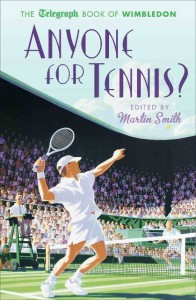- 0
 Martin Smith spent more than 20 years on staff at The Daily Telegraph as assistant sports editor and sports writer and, as such, is well placed to edit the sporting anthologies culled from the newspaper’s prodigious output. To his previous compilations on the Tour de France and Formula One, has been added ‘Anyone for Tennis? – The Telegraph Book of Wimbledon’ (Aurum, £20), just in time for this year’s Championships. As the grass court season gets serious from today, with the AEGON Championships at Queen’s Club, Smith picks some of his favourite moments from the book.
Martin Smith spent more than 20 years on staff at The Daily Telegraph as assistant sports editor and sports writer and, as such, is well placed to edit the sporting anthologies culled from the newspaper’s prodigious output. To his previous compilations on the Tour de France and Formula One, has been added ‘Anyone for Tennis? – The Telegraph Book of Wimbledon’ (Aurum, £20), just in time for this year’s Championships. As the grass court season gets serious from today, with the AEGON Championships at Queen’s Club, Smith picks some of his favourite moments from the book.
.
By Martin Smith
7 June 2010
.
IT’S a bit like being a miner. That may be frivolous, but the allusion is enhanced by the coal dust-like residue left on fingertips after sifting through mounds of yellowing newspaper cuttings. Or perhaps it is that hacking away at the coal face in a room with no natural daylight, while unearthing the occasional nugget, is like working underground. The archives of The Daily Telegraph, going back more than a century and a half, provide rich seams: it is a miner-cum-compiler’s dream.
For example. Looking through the files on Suzanne Lenglen you suddenly chance upon a piece written by Teddy Tinling, better known for adding the ribbons and bows, lace and frills, to the female players’ outfits throughout the middle of the Twentieth Century.
In an instant you are transported back to a golden age of lawn tennis when French flair and elegance took centre stage. As a teenage boy sent to the Riviera because of his asthma, Tinling fell in with the Lenglens, and was often called upon to umpire matches at Suzanne’s home club in Nice. One day, as her opponents waited not entirely patiently for her arrival, Tinling was despatched to see what was detaining her.
“As I approached,” he wrote in the Telegraph in 1961, “the iron gates opened and Suzanne, smiling radiantly, came out. ‘I was just coming to fetch you, Mademoiselle,’ I said. Her face went as dark as a mistral sky. ‘Fetch me,’ she said. ‘Fetch me?’ And she turned about, re-entered the house and slammed the door.
“The experience stood me in good stead in later years when it was my duty at Wimbledon to prepare temperamental players for their matches, to escort them on to the Centre Court, and to commiserate with them or offer my congratulations when they came off.”
Mlle Lenglen it was who hit the last shot at the original ground in Worple Road before Wimbledon moved to its present address in Church Road. A. Wallis Myers, the Telegraph’s tennis correspondent from 1909 until his death in 1939, describes the “smash severe enough to knock the racket out of Mrs Peacock’s hand.
“I add,” he concludes, “that incident to Centre Court annals, in case some future historian may search for the closing stroke on a court of so many burning memories.” A frisson traverses the divide of almost a century: hey, that’s me!
Then there is the reminder that before settling down to write ‘Birdsong’, ‘Charlotte Gray’ and ‘Human Traces’, Sebastian Faulks was a general features writer on the Telegraph staff. Back in 1985 he wrote a long, well-researched essay offering an insightful tour of the All England Club from the perspective of an up-and-coming player arriving for the first time.
A paragraph, chosen at random: “The practice courts are far away at the north end of the ground beyond a former rugby pitch. Here you catch your first sight of what Ginger Rogers has called ‘the most beautiful legs in the world’. They belong to Hana Mandlikova, the capriciously gifted world No. 3, a young player of wonderful elegance.”
The publishers’ brief for ‘Anyone For Tennis?’ was not merely to produce a book about tennis, but to capture Wimbledon’s place in the midsummer social season. Indeed, Wimbledon invades just about every part of the Telegraph during The Fortnight, and the intensive mining discovers recipes for Wimbledon picnics, how to grow your lawn to Centre Court standard, and the identity of the distinctive shade of green paint splashed all over the All-England Club.
Finally, it was intriguing to learn that the clichéd “strawberries and cream”, beloved by journalists as shorthand for the leisurely ambience of Wimbledon, is not a modern phenomenon. In 1881, just four years after the inaugural Lawn Tennis Championship, the Telegraph correspondent noted that as the Challenge final was about to begin, “the refreshment pavilion emptied directly…for strawberries and cream and even ices, notwithstanding that the heat of the sun was almost intolerable, had no charms for the enthusiastic multitude once the rivals were ordered to be ready”.
The ices will barely have melted. The 1881 final was one of the most one-sided in the tournament’s 133-year history: William Renshaw crushed the Rev John Hartley 6-0, 6-1, 6-1 to win the first of his seven titles. Roger Federer, meanwhile, hopes to replicate the feat this year by lifting the golden trophy a seventh time; more burning memories in prospect for a future historian to uncover.
.
BUY: Anyone for Tennis?: The Telegraph Book of Wimbledon (Daily Telegraph)
.









